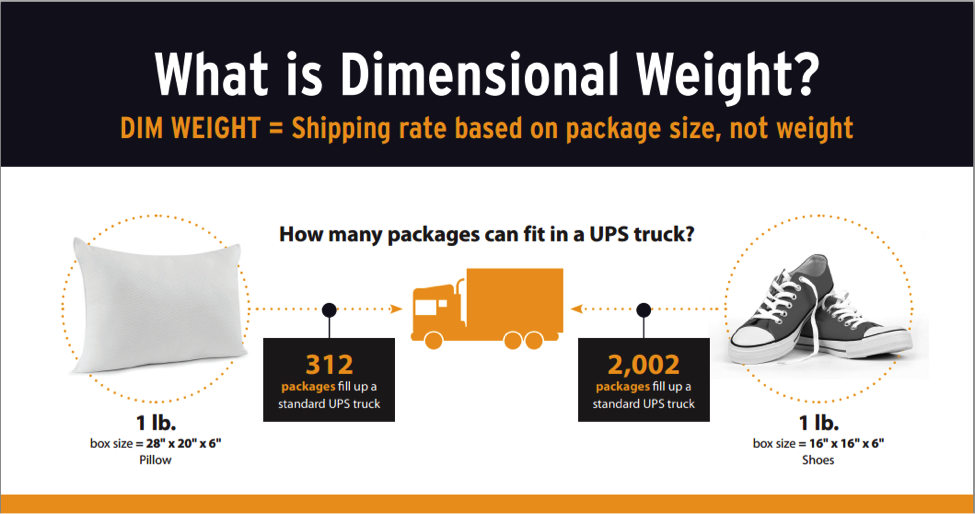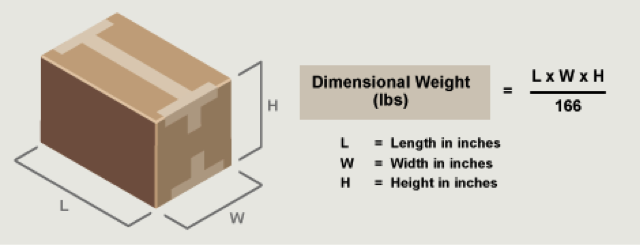
A big surprise to no one, shipping rates recently experienced another hike at the beginning of this year. The two major US players, UPS and FedEx, both raised their rates by an average of 4.9%, as well as increased select fees and surcharges associated with their service. These increases corresponded with a major decrease in oil prices, which surprised many consumers since fuel costs are so important to determining overall rates and fees.
More interesting, however, was the announcement that UPS and FedEx shifted the basis of their shipping rates from the weight of a package to the size of a package. This method for determining rates is known as Dimensional Weight Pricing (DIM Pricing), and is designed to be more cost-effective for shipping carriers.
To learn more about what these shifts mean to you and your bottom line, check out this quick guide.
What is dimensional weight pricing?
Why the move to DIM Pricing? Simply put, it makes more sense (and cents) for shipping providers. Think of it this way: shipping providers want to load as many packages onto their trucks as possible, meaning that space is at a premium, not weight. In other words, you can ship two packages with the exact same weight, but one can take up a lot more space on a truck than the other.To better illustrate this idea, take a look at this example from our friends at Stamps.com:

Long story short, shipping providers much prefer smaller packages to larger ones, which explains FedEx and UPS’ recent decision to move to dimensional shipping via DIM Pricing.
How do I calculate dimensional weight?
In order to calculate dimensional weight, you’ll need to measure the amount of space a package takes up, also known as its volume. Here are the instructions for measuring dimensional weight with UPS:“Determine the package dimensions in inches. For each dimension, measure at the longest point, rounding each measurement to the nearest whole number (for example, 1.00 to 1.49 will be considered 1, and 1.50 to 1.99 will be considered 2). Multiply the package length by the height. The result is cubic size in inches. Divide the cubic size in inches by 166 to determine dimensional weight in pounds. Increase any fraction to the next whole pound.”
Sound complicated? You’re not alone. To better clarify, here’s an image from UPS which details their formula for domestic shipments:

But wait, there’s more! Now that you’ve calculated dimensional weight, it’s time to determine the actual weight, which is how much the package weighs in pounds. Whichever has the highest “weight” between the two is considered the “billable weight,” and should be used to calculate the shipping rate.
To provide an example, let’s say you’re shipping a pair of loafers domestically with UPS or FedEx in a 12 x 12 x 8 box. The dimensional weight is calculated at 6.94 pounds ((12x12x8)/166)), which rounds up to 7. The actual weight, however, is only 4 pounds. This means that the billable weight would be 7 pounds since the dimensional weight is higher than the actual weight.
In a nutshell, not only did standard shipping rates rise earlier this year, the move to focusing on dimensional weight can greatly increase shipping costs for you, no matter what you’re selling.
How can I manage shipping costs?
Although shipping costs are on the rise, never fear, there are some simple measures you can take to manage your shipping costs while providing a better customer experience:- Consider flat-rate or free shipping: The ecommerce industry is quickly moving to offering free shipping, free shipping with a certain dollar amount and flat-rate shipping. As Amazon and Zappos have set industry standards, consumers now expect to know the shipping cost when they begin shopping, and are extremely likely to abandon their cart if they see an unexpectedly high shipping cost when checking out. With dimensional shipping now in play, customers will be required to pay more for shipping, which means they’re less likely to complete a purchase. Offering flat-rate or free shipping will prime you to reduce abandoned carts and increase conversions.
- Utilize smaller packaging: When it comes to dimensional weight, size matters. This means that you should evaluate your current packaging and find areas to downsize. For example, can you ship your items in a smaller box? What about in envelopes? Wherever you can find opportunities to decrease your dimensional weight without compromising quality, go for it.
- Consider multiple shipping providers: Different shipping providers have different rates, so look into which is the most cost-effective for your business. For example, the United States Postal Service (USPS) only charges dimensional shipping rates when a package is larger than a cubic foot and is traveling longer distances (zones 5-8). FedEx and UPS, however, are both great options for shipping larger packages. Evaluating which carrier and methods are best for your business is a quick and easy way to ensure you’re getting the best deal.
So, there you have it: a quick and easy guide to understanding why shipping rates are increasing, how to address dimensional weight and how to reduce shipping costs. Stay tuned to ongoing updates from major shipping carriers as the landscape in this industry is ever-evolving.











